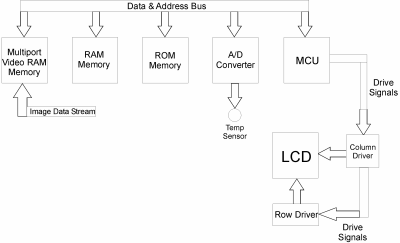Adaptive Addressing
"Adaptive Addressing" for enhanced low
temperature operation.
|
Adaptive Addressing is an effective way to improve the
performance of an LCD at low temperatures. It is a patented
method that was developed under a DARPA grant and has been
successfully implemented in displays of varying complexity.
Liquid Crystal Technologies has the exclusive US rights to
this technology for use in enhancing the cold temperature
operation of a display.
|
How it works:
The block diagram below shows the basic architecture of an LCD module using Adaptive Addressing. The image data stream does not go directly to the row and column drivers as in a traditional module. Instead it goes into the dual-ported video buffer, where the high-speed MCU can access the pixels and determine which pixels need to be updated. It also updates a few pixel tables in its own RAM memory that keep track of a number of pixel characteristics.When the processing for any given frame is completed, the data is sent to the LCD thru the specialized row and column drivers. The dual-ported video RAM is then ready to accept the next frame of image data.
 |
Discussions:
|
Conclusions:
Some of the benefits of Adaptive Addressing are:
|
The design of an LCD module using Adaptive Addressing is straightforward, however it does require a very close working relationship with the customer.
Because every design requirement is different, the best way to move ahead is to call us at (440) 232-8590 to talk to one of our engineering specialists about how "Adaptive Addressing" can solve your low temperature design problems.
